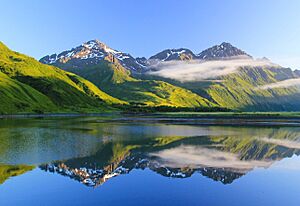Three Saints Bay, Alaska facts for kids
|
Three Saints Bay Site
|
|

1802 lithograph engraving depicting the site
|
|
| Location | Address restricted |
|---|---|
| Nearest city | Old Harbor, Alaska |
| Built | 1784 |
| NRHP reference No. | 72001541 |
Quick facts for kids Significant dates |
|
| Added to NRHP | February 23, 1972 |
| Designated NHL | June 2, 1978 |
Three Saints Bay is a long inlet, like a narrow arm of the sea, located on the southeast side of Kodiak Island in Alaska. It stretches about 9 miles (14 kilometers) and is found north of Sitkalidak Strait. The Three Saints Bay Site is a very important archaeological site. It marks the spot of the very first Russian settlement in Alaska, which was called Three Saints Harbor.
This first settlement was started in 1784 by a man named Grigory Shelikhov. However, the main settlement later moved in 1792. It moved to a new place called Pavlovskaya Gavan, which is now known as the city of Kodiak. Because of its historical importance, the Three Saints Bay Site was named a National Historic Landmark by the United States in 1978.
Contents
History of the First Russian Settlement
Russian fur hunters had visited Alaska before, setting up temporary camps. But the Three Saints Bay site was different. It was meant to be a permanent home for the Russian colonists.
Why the Location Was a Challenge
The chosen spot for the settlement wasn't ideal. The hillside above the shore was too steep for building many structures. Also, the shore area itself was quite small. This made it hard to build a large settlement.
When people visited in 1790, they described it as a small group of buildings. These were likely simple structures called barabaras. About fifty men and a few women lived there.
Moving the Settlement
The site faced problems, including damage from an earthquake in 1788. This earthquake likely caused the ground to sink and possibly created a tsunami. Because of these issues, Alexander Baranov started moving the main Russian settlement in 1791. They moved to the place where the city of Kodiak stands today.
Even after the main group moved, the original Three Saints Bay site was still used. It became a smaller, less important station until the mid-1800s. After that, it was moved again, about 1.2 miles (2 kilometers) away.
What Remains Today
Today, you can only see a few signs of the old Russian settlement on the surface. These include pits and rectangular dips in the ground. These show where buildings once stood. You might also see some plants that grew from the small farms they had there. The settlement's cemetery was located to the southeast of the main area.
When archaeologists dug at the site, they found something even older. They discovered that the Russian settlement was built on top of an even older native settlement. This older settlement dated back to around 100 BCE.
The Russian settlement site was officially added to the United States National Register of Historic Places in 1972. It was then named a National Historic Landmark in 1978.
The Name: Three Saints Bay
The bay got its name from the harbor, which was named after one of Shelikhov's ships. This ship was named in honor of the Three Holy Hierarchs. This name was first reported in 1880.
Later, Captain Tebenkov called the same area Lyakhik Bay. This name came from the local Aleut name Liakik. It probably means "black-footed goose" in the Aleut language.



